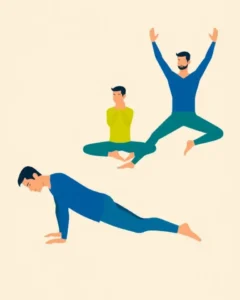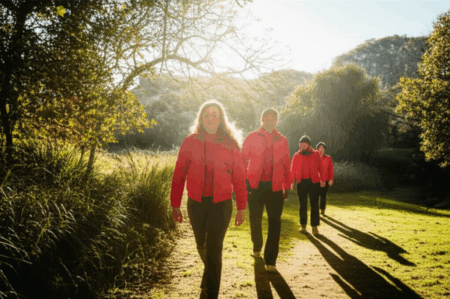What if your daily walk could burn more fat, lower your blood pressure, and even make you feel younger? Japanese walking techniques are attracting global attention as a simple yet effective way to boost your health and well-being. Let’s explore two popular methods: Namba walking and Interval Walking Training (IWT), and how a 30-minute routine can revolutionize your fitness.
Two Paths to Wellness: Namba Walking and Interval Walking Training
The term “Japanese walking” encompasses two distinct practices:
- Namba Walking: A traditional technique emphasizing efficient, balanced movement rooted in ancient samurai traditions.
- Interval Walking Training (IWT): A modern, science-backed method alternating between brisk and slow walking periods.
While both originate from Japan and offer unique advantages, IWT has been widely studied and is gaining significant traction for its remarkable health outcomes.
The Samurai Secret: Unlocking the Power of Namba Walking
What is Namba Walking?
Namba Walking, also known as the “Samurai walk,” is a traditional Japanese walking style focused on efficiency, stability, and minimizing unnecessary movements. Dating back to the Edo period (1603-1868), this technique was used by samurai, messengers, and others who needed to cover long distances with minimal fatigue.
How Namba Walking Works
Unlike modern Western walking, which involves twisting the torso and swinging opposite arms and legs, Namba Walking emphasizes synchronizing the movements of the same side of the body. Here’s a breakdown of the key principles:
- Same-Side Coordination: Move the right arm and right leg forward simultaneously, followed by the left arm and left leg.
- Minimize Twisting: Keep the upper body stable and avoid twisting the torso.
- Engage the Core: Initiate movement from the “tanden” (lower abdomen), maintaining a strong core.
- Short Strides: Take smaller, more controlled steps, keeping your legs under your pelvis.
- Soft Foot Landing: Avoid a harsh heel strike, landing softly on the front part of the sole followed by the heel.
- Upright Posture: Maintain a straight back, relaxed shoulders, and head held high, focusing your eyes on the horizon.
Benefits of Namba Walking
- Increased Stamina: By minimizing twisting and wasted movements, Namba Walking reduces strain on the body, leading to longer-lasting stamina.
- Stable Posture: Keeping the upper body stable promotes better posture and reduces unnecessary twists.
- Energy Efficiency: Namba Walking is designed to minimize wasted energy, making it ideal for long distances and reducing fatigue.
- Joint Stress Reduction: The soft foot landing and emphasis on core engagement help reduce stress on joints, particularly the knees and ankles.
- Balance and Coordination: The focus on stability and controlled movements enhances balance and coordination.
- Mindfulness: Namba Walking encourages a focused and mindful approach to movement, promoting mental clarity and relaxation.
- Suitable for Traditional Clothing: Namba Walking helps prevent kimonos from getting rumpled and keeps swords from swinging, showcasing its practicality for traditional Japanese attire.
How to Practice Namba Walking
- Posture Alignment: Begin by standing against a wall, ensuring your heels, hips, shoulders, and the back of your head are aligned.
- Tanden Engagement: Focus on initiating movement from your lower abdomen (tanden).
- Same-Side Movement: Practice moving your right arm and right leg forward together, followed by your left arm and left leg.
- Minimize Twisting: Keep your upper body facing forward, avoiding unnecessary twisting.
- Short, Soft Steps: Take small, controlled steps, landing softly on your feet.
- Arm Movement: Keep your arms close to your body, moving them vertically in sync with your legs, not swinging them across your body.
- Practice Regularly: Consistency is key to mastering Namba Walking and experiencing its benefits.
Namba Walking in Modern Life
While originally designed for ancient Japan, Namba Walking can be adapted to modern lifestyles. It’s a way for people to focus their movement, breathing, and walking with more control and balance. Walking with less excessive force and energy leads to reduced stress on both body and mind.
Supercharge Your Stroll: The Science of Interval Walking Training (IWT)
What is Japanese Interval Walking Training (IWT)?
Developed by exercise physiologist Dr. Hiroshi Nose, IWT is a science-backed method that alternates between periods of brisk walking and easy pacing. A typical 30-minute session involves repeating a cycle five times:
- Three minutes of fast walking
- Three minutes of slow walking
The brisk intervals should be challenging enough to significantly elevate your heart rate, feeling like you’re rushing to an important meeting, while the slower periods allow for active recovery. This approach is a form of low-impact High-Intensity Interval Training (HIIT), making it accessible to a wider range of individuals, including seniors, beginners, and those recovering from a sedentary lifestyle. Unlike continuous moderate-paced walking, IWT intentionally pushes your body in short bursts,
Why IWT Works
The effectiveness of IWT lies in its ability to mimic the benefits of high-intensity interval training (HIIT) without the high-impact stress on the body. During the fast-paced intervals, your body taps into glycogen stores and increases oxygen demand, triggering a cascade of metabolic benefits. The alternation between effort and recovery mimics the rhythm of elite athlete training, just with lower impact, making it ideal for seniors, beginners, or anyone recovering from a sedentary slump. This burst-and-breathe pattern revs up your heart rate, challenges muscle coordination, and improves balance, especially in older adults.
Proven Health Benefits of IWT
Numerous studies have demonstrated the remarkable health benefits of IWT:
- Improved Cardiovascular Health: IWT significantly improves aerobic capacity (VO2 max), strengthens the heart, and can lead to better blood pressure regulation. Studies have shown that participants can see a greater improvement in blood pressure than those who simply walk 10,000 steps a day at a consistent pace.
- Increased Muscle Strength and Bone Density: The varying intensity helps activate more muscle fibers, particularly in the thighs and glutes, leading to improved muscle strength and bone density.
- Better Blood Sugar Regulation: IWT can improve blood sugar levels and insulin sensitivity, making it beneficial for individuals with or at risk of type 2 diabetes.
- Weight Management: By boosting metabolism and increasing calorie burn, IWT can aid in weight loss and the afterburn effect, where your metabolism remains elevated for hours after you finish walking, continuing to burn calories at a higher rate.
- Reversal of Lifestyle Diseases: Studies have shown that consistent IWT practice can significantly reduce symptoms of lifestyle diseases like hypertension and obesity.
- Mental Health Benefits: The circulation boost helps detoxify organs, enhance nutrient absorption, and sharpen mental clarity, making it not just a physical workout, but a rejuvenating full-body experience.
- Increased Aerobic Fitness and Leg Strength: Consistent IWT participants improved their aerobic power and thigh muscle strength by 20%, enough to make you feel ten years younger.
- Improved Cholesterol: Those who practiced this walking method four times a week for three months saw measurable improvements in cholesterol.
Getting Started with IWT
IWT is incredibly accessible and requires no special equipment:
- Warm-up: Begin with a few minutes of easy walking to warm up your muscles.
- Intervals: Alternate between 3 minutes of brisk walking (a pace where you can talk but are slightly breathless) and 3 minutes of slow walking (a comfortable, easy pace).
- Repeat: Repeat the cycle five times for a total of 30 minutes.
- Cool-down: Finish with a few minutes of easy walking to cool down.
- Progression: As you get fitter, you can increase the duration of the fast intervals or the overall session length.
Japanese Walking: A Sustainable Fitness Solution
Both Namba walking and IWT offer sustainable, accessible ways to improve your health and fitness. Namba walking provides a mindful, efficient approach to daily movement, while IWT delivers a science-backed, time-efficient workout that can be easily incorporated into your routine. Whether you’re seeking to enhance your physical well-being, boost your mental clarity, or simply add more movement to your day, consider embracing the wisdom of Japanese walking.
By incorporating these techniques into your life, you can unlock a wealth of benefits and experience the transformative power of a simple, yet profound, approach to fitness. So, step aside treadmill, and embrace the ancient and modern secrets of Japanese walking for a healthier, happier you!







